
The Meaning of the Black Ribbon
The black ribbon is a multifaceted symbol of mourning, respect, and remembrance, often worn to honor those we've lost. This article sheds light on its importance in the context of skin cancer, while acknowledging its broader symbolism in representing various causes such as sleep disorders, POW (Prisoners of War), MIA (Missing in Action) soldiers, and anti-gang initiatives.
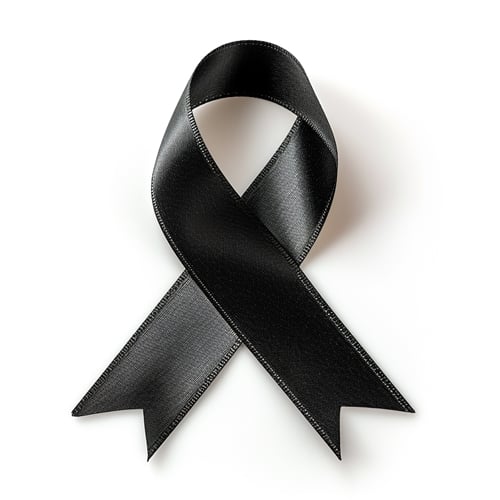 What is the color for skin cancer awareness?
What is the color for skin cancer awareness?
The color for skin cancer awareness is black. Cancer ribbon colors represent different types of carcinoma, and skin malignancies are a serious issue that affect millions of people around the world. Skin cancer is one of the most common forms of carcinoma in the United States, with more than 5 million cases diagnosed each year. [1]
While skin malignancy can affect anyone, regardless of age, race or ethnicity, it is more common in people with a pale or white complexion due to the lack of a protective pigment called melanin.
However, it's important that people with darker skin tones do not consider themselves immune just because their melanin provides some protection. UV exposure raises your risk regardless of skin color, and steps should be taken to protect against the sun no matter what.
The Importance of Early Detection: Understanding Melanoma and the Black Symbol
It's essential to remember that skin malignancies are a serious health concern that affect millions of people each year. Like breast cancer, early detection and prevention are critical in the fight against these malignancies, making awareness campaigns and initiatives like the black skin cancer ribbon all the more vital and important.
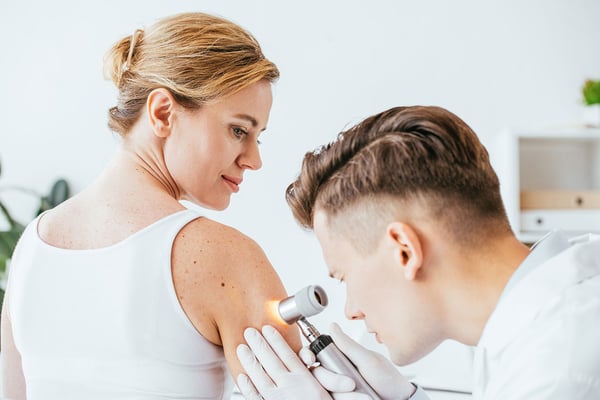 What is Melanoma?
What is Melanoma?
Melanoma is a type of cancer that starts in melanocytes, the cells that produce melanin. Melanin is the pigment that gives skin its color. Melanoma can develop anywhere on the body, but it is most commonly found on the skin of the face, neck, and arms.
Melanoma: The Deadliest Form of Skin Lesion
Melanoma is the deadliest form of skin malignancies, but it is also one of the most preventable carcinomas. Most melanomas can be cured if they are detected early. Early detection is important because melanoma can spread quickly. If melanoma is detected in early stages, it is more likely to be cured.
According to the Skin Cancer Foundation, one in five Americans will develop dermatological cancer in their lifetime. And Melanoma is responsible for 75% of all skin cancer deaths. [2] That's why it's essential to protect yourself from the sun's harmful UV rays.
While melanoma is more commonly found in adults, it is important to recognize that children and adolescents can also be affected by this deadly lesion. In fact, if skin carcinoma is detected in younger individuals, it is more likely to be melanoma.
Unfortunately, due to its rarity in this age group, many cases of pediatric melanomas are not detected until later stages, which can make treatment more challenging. It's crucial for parents and caregivers to be aware of the signs and symptoms of skin carcinomas in children and to seek medical attention if they notice any unusual changes in their child's skin.
Here's a fact that might surprise you
Even one blistering sunburn during childhood or adolescence can double a person's risk of developing melanoma later in life. [3]
That's why it's crucial to protect yourself during childhood when the epidermis is more susceptible to damage, so that you can ensure a healthier future for yourself.
Why the Black Ribbon for Melanoma?
The black skin cancer ribbon was chosen because melanoma is also known as the black tumor. The color black is often associated with strength, determination, and power, which are all qualities that are associated with those who have been affected by melanoma. Additionally, darker skin tones are at higher risk of these carcinomas going untreated far longer due to a false sense of protection, and the color black skin cancer ribbon also serves to bring more attention to this.
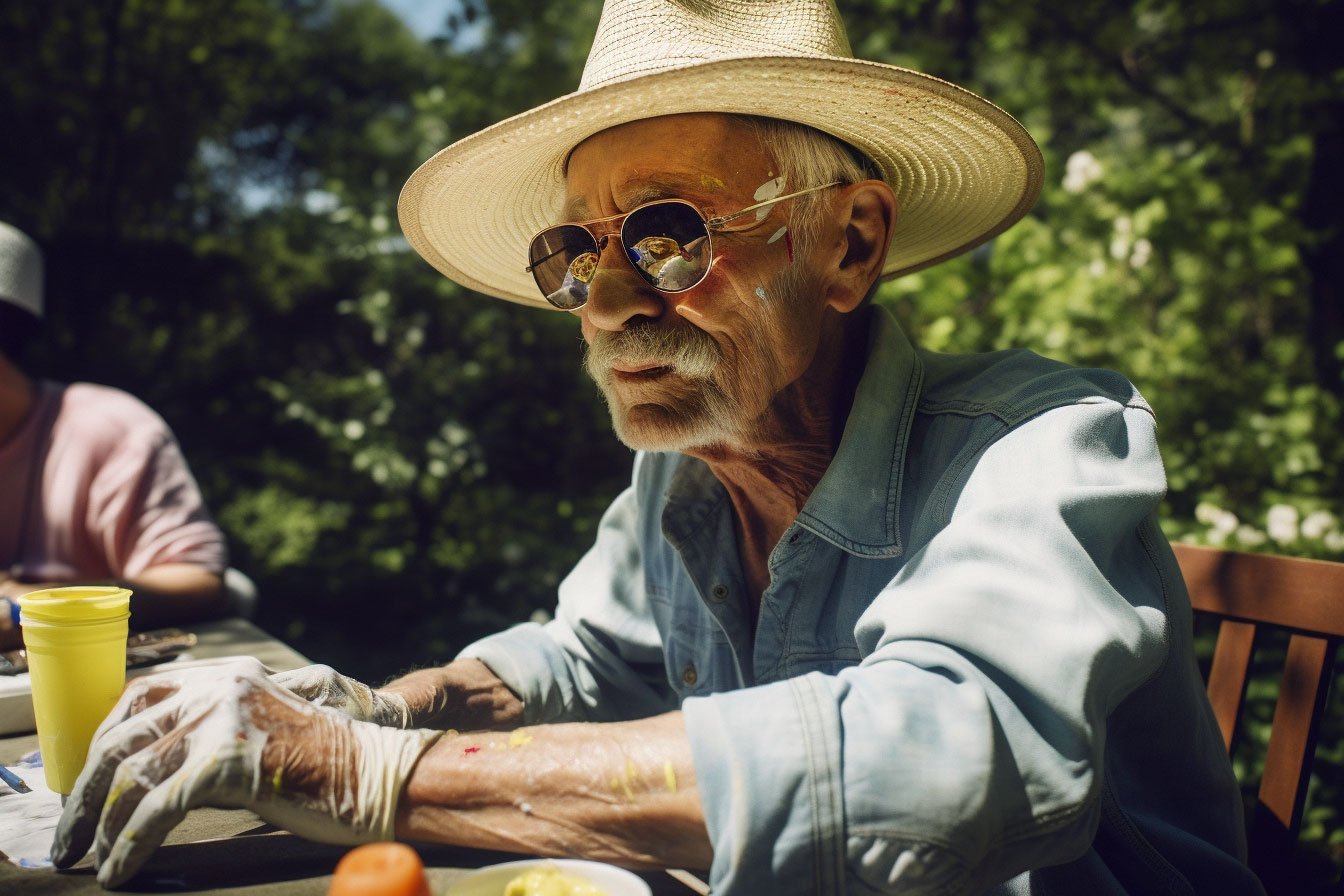
Risk and Environmental Factors
UV rays from the sun can damage your skin in as little as 5 to 10 minutes. In fact, there are several risk factors involved that can increase a person's likelihood of developing sun-induced melanoma. [4]
In addition to UV exposure, other factors can increase your risk, such as exposure to certain chemicals and a weakened immune system.
Sunburns and Sun Exposure
Fair skin, light eyes, and light hair are the most significant risk factors, as people with these traits are more susceptible to damage from the sun's UV rays.
Those who spend prolonged periods in the sun, particularly during peak hours, are also at increased risk.
Skin lesions can develop anywhere on the body, including areas that are not typically exposed to the sun, such as the soles of the feet, scalp, and even underneath the fingernails. [5]
Beyond Sunscreen: Protective Clothing and Other Strategies
People with a history of sunburns or excessive sun exposure, especially during childhood, are also at higher risk for developing dermatologic cancer. Other risk factors include having a family history of skin carcinoma, having a large number of moles or atypical moles, and having a weakened immune system due to a medical condition or medication.
Another interesting fact
Did you know that skin cancer is more common in men than women? According to an article by the American Cancer Society, men are twice as likely to develop this disease as women. [6]
So, guys, make sure you're taking care of your epidermis too!

While sun exposure is the primary environmental factor that can contribute to skin carcinoma, there are other environmental factors to consider as well. Exposure to air pollution, for example, has been linked to an increased risk of skin cancer. Certain chemicals, such as arsenic, have also been shown to increase the likelihood of developing the disease.
Also, people who work in certain industries, such as agriculture or construction, may be exposed to chemicals or other substances that can increase their risk of cancers. It's important to be aware of these environmental factors and take steps to reduce exposure whenever possible, such as putting on protective clothing or avoiding exposure during peak hours.
Prevention Strategies for Reducing Skin Cancer Risk
According to the American Academy of Dermatology, more people are diagnosed with skin malignancy each year in the United States than all other cancers combined.
A Pearl of Wisdom and Caution
In a report published by the National Cancer Institute, cancer rates are on the rise in the United States. From 2000 to 2010, the incidence of skin cancers increased by 4.2%. [7]
Prevention is key when it comes to skin malignancies. There are several steps you can take to reduce your risk of developing the disease. One of the most important strategies is to protect your skin from the sun's harmful UV rays. This can be done by seeking shade during peak hours, wearing protective clothing like long-sleeved shirts and hats (with a black ribbon 😉), and using a broad-spectrum sunscreen with an SPF of 30 or higher.
Hidden Hazards: Indoor and Driving Exposure to UV Rays
Did you know that skin carcinoma is more common on the left side of the body? This is because the left side of the body is more exposed to UV rays while driving.
Melanoma is not just a concern for beachgoers and outdoor enthusiasts. People who work indoors or in cars for extended periods are also at risk, as UV rays can penetrate through windows. [8] It's also important to avoid tanning beds, as they can increase your risk of skin cancer.
Additionally, it's a good idea to perform regular self-exams to check for any changes in moles or other marks on your skin. If you notice any changes, such as a new mole or a mole that has changed in size, shape, or color, it's important to see a dermatologist right away.
Another Pearl of Wisdom: UV radiation-induced lesions can occur anywhere on the body, not just in areas exposed to the sun. By taking the proper steps to self-check, you can help protect yourself from malignancies and catch them early if they do develop.
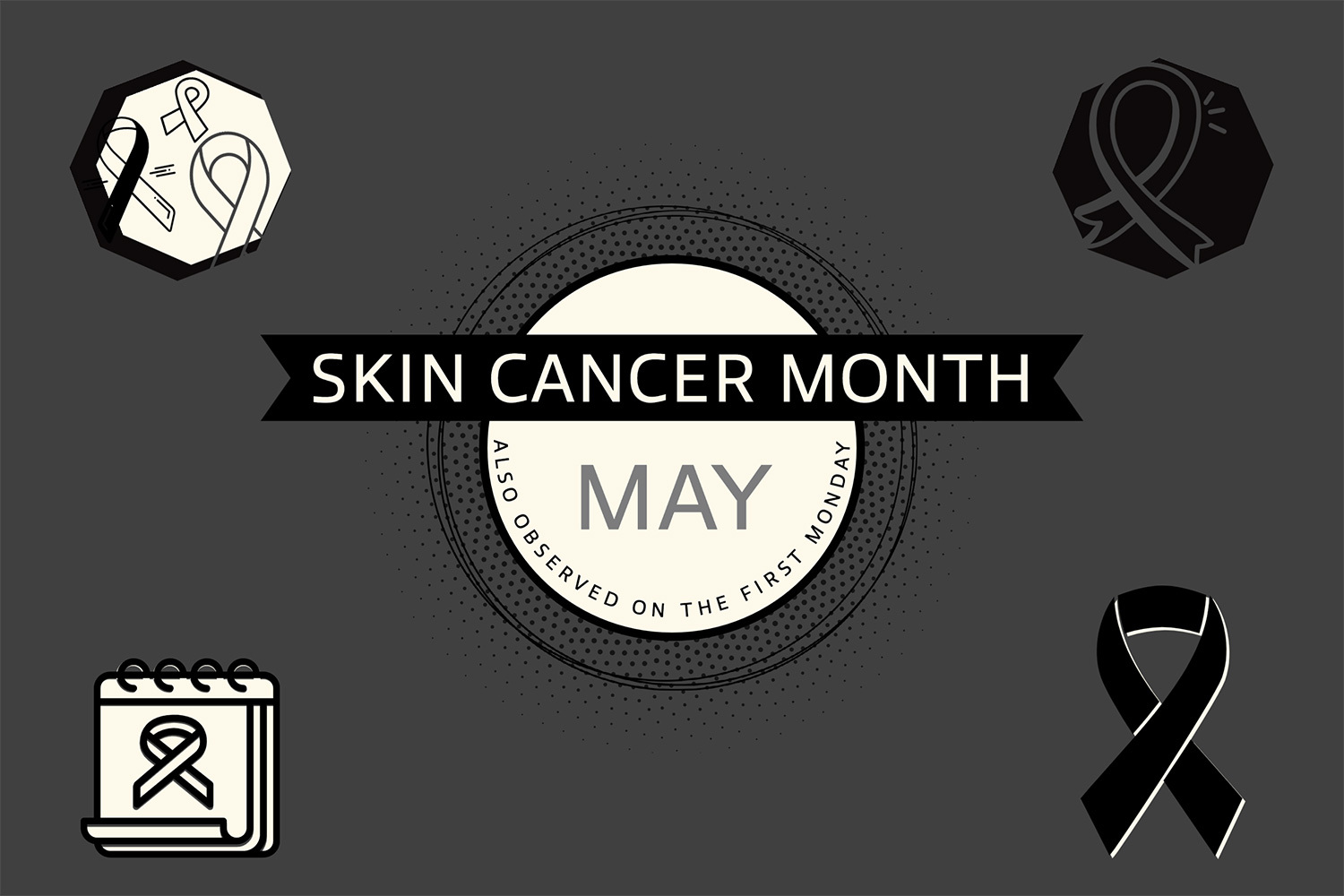
When is skin cancer awareness month?
Skin Cancer Awareness Month is observed annually in May, and it's the perfect opportunity to raise awareness about the risks and promote early detection. With summer just around the corner, it's essential to protect ourselves from the sun's harmful rays. But, unfortunately, many people still think that tanning beds and sunburns are harmless. That's why Skin Cancer Awareness Month is so crucial. It's a time to educate ourselves and our loved ones about the dangers of sun exposure and the importance of sunscreen.
Recognizing Melanoma Monday: A Day for Awareness and Action
Melanoma Monday is a significant annual event designed to raise awareness of melanoma, the deadliest form of lesion. Held on the first Monday in May, this day emphasizes the importance of early detection, diagnosis and prevention to save lives. By raising awareness about the risk factors, signs, and symptoms of melanoma, we empower individuals to take charge of their skin health and save others.
On Melanoma Monday, we encourage everyone involved to perform regular skin self-exams, schedule appointments with dermatologists, research and practice sun-safe habits, such as applying sunscreen, wearing protective clothing, and seeking shade. By raising awareness and joining forces on this day, we can create a global movement to fight melanoma and ultimately reduce its impact on our communities.
The Significance of World Cancer Day
When looking to support those affected by cancer, it's important to remember that there are many different types of cancer ribbon colors. Blue and Orange are the official colors for World Cancer Day, but in the past the color purple was chosen because of how many different cancers it represented.
For example, pancreatic cancer is represented by a lavender ribbon, while other types of cancer, such as Hodgkin's lymphoma and leiomyosarcoma, are represented by the more well-known purple ribbon. Additionally, there are other shades of purple, such as light purple ribbon, and even lavender-colored ribbons, that are used to raise awareness for different types of cancer.
By incorporating these ribbons or colorful wristbands into your fundraising or awareness efforts, you can help spread the word about the image of hope and support that these colors represent.
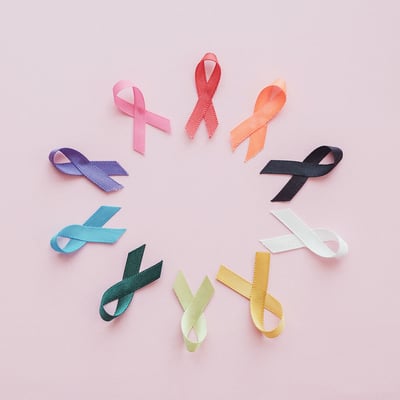 The Power of Ribbons: Borrowing from Breast Cancer Awareness Month to Boost Efforts
The Power of Ribbons: Borrowing from Breast Cancer Awareness Month to Boost Efforts
Cancer ribbon colors help organize communities around each cancer to enhance awareness efforts. For example, the pink ribbon has become synonymous with breast cancer awareness month in October, and the same could be accomplished with the black ribbon for May.
It's important to note that the the de facto pink symbol for breast cancer awareness was created in 1991 by the Susan G. Komen Foundation. [9] It was this foundation's efforts that helped make "the pink ribbon" a nationally recognized symbol of hope, strength, and solidarity for those affected by breast cancer. A similar phenomenon could also happen with other common cancer ribbons, but specifically the black ribbon could be "the sign" of much needed support for those suffering from a melanoma diagnosis.
Making a Statement With Custom Silicone Wristbands
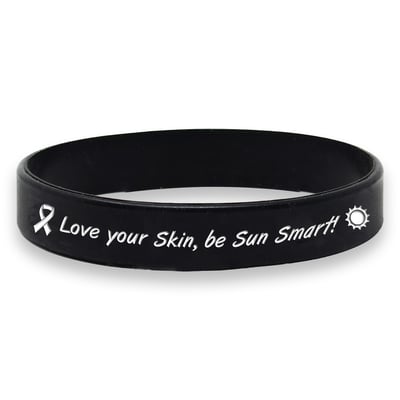
One way to show your support for Skin Cancer Awareness Month is by wearing a wristband or ribbon to raise awareness. Add the black skin cancer ribbon icon to your wristband or wear another ribbon design as a symbol of hope and a reminder that we are not alone in the fight against skin malignancy.
Alternatively, black cancer wristbands can be personalized with a message or design of your choosing, making them a unique and meaningful way to wear and show your commitment to the cause. These bracelets can serve as a conversation starter, a tool for raising funds, and allow you to share information about skin melanomas and the importance of early detection with others.
Whether you're looking to raise awareness among your friends and family or at a larger event or fundraiser, custom silicone wristbands can be a powerful campaign tool in the fight against cancer.
You can also donate to organizations that provide cancer research and education to support them and help raise funds. Every little bit helps!
Is there a slogan for skin cancer?

The Slip, Slop, Slap slogan has become a well-known and effective way to raise concerns about sun protection and prevention. It originated in Australia in 1981 as part of a health campaign launched by the Cancer Council. [10]
The program featured a character named Sid the Seagull, who danced across television screens while singing a catchy jingle about slipping on a shirt, slopping on sunscreen, and slapping on a hat to protect against the sun. Since then, the initiative has been updated to include additional steps like seeking shade and sliding on sunglasses, and the slogan has been adopted by other countries as well. Its simple message and memorable tune have helped to make it one of the most successful health campaigns in history
When it comes to promoting sun safety for kids and the youth, it's important to use creative and engaging methods to capture their attention. Incorporating fun and colorful characters, songs, or interactive activities can make sun protection more appealing and enjoyable for them.
In addition to the Slip, Slop, Slap slogan, there are many other unique and inspiring slogans that can help promote sun safety and skin cancer prevention. Some examples include "Sunscreen is a lotion, not a potion," "Don't fry, protect and apply," "Be shady, wear a hat," and "Your skin is in, protect it." These slogans can be used in various settings, such as schools, outdoor events, and social media awareness campaigns, to get the word out and encourage healthy sun habits.
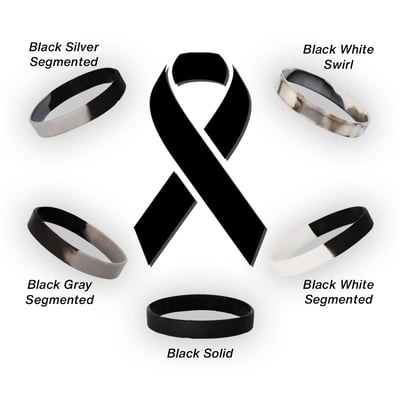
- Ribbon Color: Black
- Pantone Code: Black C
- Hex Color Code: #000000
- Rapidwristbands Colors: Black Silver Segmented, Black Gray Segmented, Black Solid, Black White Swirl, Black White Segmented
[1] National Library of Medicine - National Center for Biotechnology Information. The Surgeon General's Call to Action to Prevent Skin Cancer https://www.ncbi.nlm.nih.gov/books/NBK247164
[2] Skin Cancer Foundation https://www.skincancer.org/skin-cancer-information/skin-cancer-facts
[3] Skin Cancer Foundation https://www.skincancer.org/risk-factors/sunburn
[4] National Library of Medicine - National Center for Biotechnology Information. InformedHealth.org https://www.ncbi.nlm.nih.gov/books/NBK321117
[5] American Cancer Society https://www.cancer.org/cancer/melanoma-skin-cancer/about/what-is-melanoma.html
[6] American Academy of Dermatology Association. https://www.aad.org/public/diseases/skin-cancer/types/common/melanoma/men-50
[7] National Cancer Institute - Surveillance, Epidemiology, and End Results Program https://seer.cancer.gov/statfacts/html/melan.html
[8] Skin Cancer Foundation https://skincancer.net/clinical/sun-exposure-driving
[9] Susan G. Komen https://www.komen.org/uploadedFiles/Content_Binaries/The_Pink_Ribbon_Story.pdf
[10] Cancer Council https://www.cancer.org.au/cancer-information/causes-and-prevention/sun-safety/campaigns-and-events/slip-slop-slap-seek-slide
.png)
.png)
.png)

.png)
.png)

.png)
.png)
.png)
.png)
.png)
.png)
.png)
.png)
.png)
.png)
.png)
